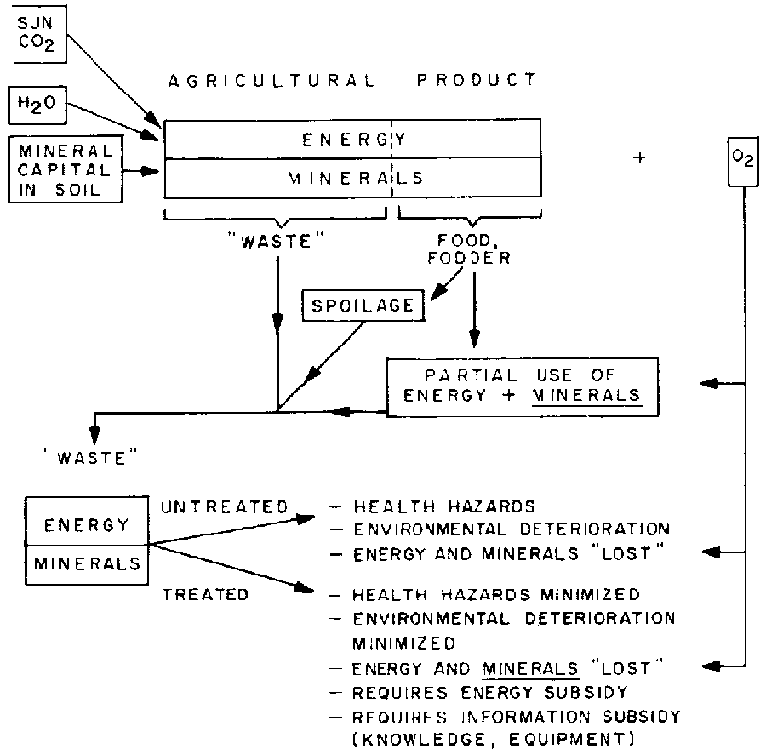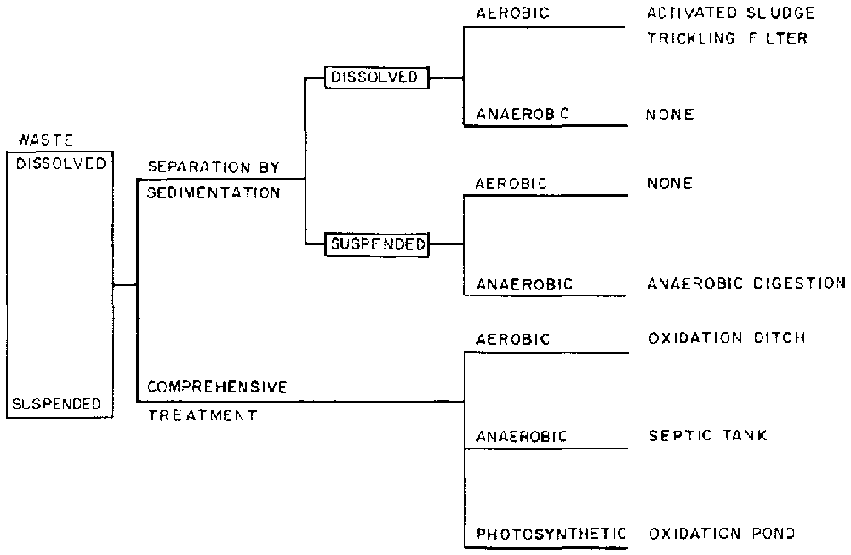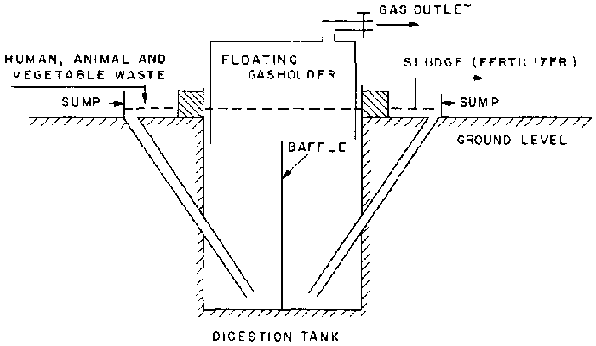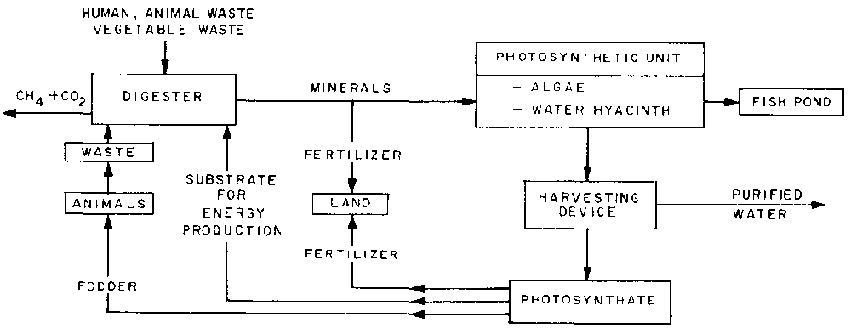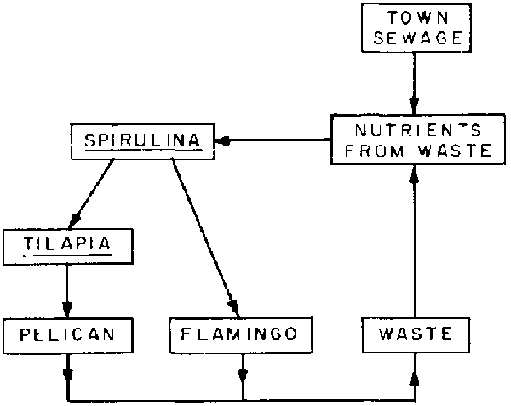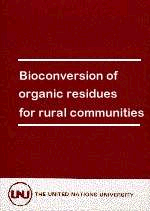
Bioconversion of Organic Residues for Rural Communities (UNU, 1979, 178 p.)
Environmental goals for microbial bioconversion in rural communities[edit | edit source]
J. W. M. La Rivière
International Institute for Hydraulic and Environmental Engineering, Delft, Netherlands
Introduction[edit | edit source]
Environmental Goals
The meaning of the word "environmental" has rapidly broadened over the past decade under the influence of the United Nations Conference on the Human Environment held in Stockholm in 1972. The 21 goals the UN Environment Programme has set for itself for 1982 include not only preservation of air, soil, and water quality and of genetic resources but also improvement of the human environment in its widest sense - that is, with respect to water, food, energy, shelter, and the ecologically sound use of natural resources (1). Thus, we now have dovetailing and blurring of demarcation lines between, say, environmental and agricultural programmes and goals. Under these circumstances, I will not attempt to draw up a sharp definition of environmental goals, but, for the sake of expediency, interpret this term, for the purposes of this paper, as pertaining to the protection of human health and of the quality and productive capacity of water and land resources, which will include recycling of minerals and energy recovery from wastes.
Waste may be defined as any material which technology does not yet know how to use at a given time and place. Hence, this term has a specific meaning only in a specific context.
Microbial Bioconversions
Since time immemorial microbial conversions have had an impact on the global environment. Microbes have helped to shape the environment as it is today, and, through their massive action in the bio-geo-chemical cycles of carbon, nitrogen, and sulphur, they help maintain a steady state in the biosphere, for instance, by balancing CO2 fixation by CO2 production in the mineralization process, and by counteracting denitrification by nitrogen fixation. Because these conversions can be influenced by man to only a small extent, we cannot say that they serve environmental goals. Instead, their results have important environmental consequences that we are obliged to accept from nature. Thus, a discussion of these conversions falls outside my mandate; I mention them briefly because the two most important types of man-mediated microbial conversions are, to some extent, intensified versions of natural conversions (Table 1).
TABLE 1. Types of Microbial Conversions
| A. Natural conversion processes in bio-geo-chemical cycles, having important environmental consequences. | |
| B. Man-mediated conversions: |
(i) Product-oriented: fermentation industry. Sterilization and use of selected organisms possible. Usually produces waste. |
|
(ii) Raw material-oriented: waste treatment. Sterilization and use of selected organisms impossible. Serves environmental goals only. | |
This is least true with respect to the modern bioconversions performed in the fermentation industry, but still, we should not forget that many of its processes also find their early origin in the microbial mineralization of freshly harvested foods like milk, grapes, and cabbage that happened to yield spoilage products that were palatable, more durable, and hygienically safe, in the form of yogurt and cheese, wine, and sauerkraut. The modern processes merely provide rigorous guidance for these desired spoilage processes in order to guarantee a reproducible product. In general, however, the modern fermentation industry is based on product-oriented processes rather than on processes designed to utilize a given raw material. Good examples are the production of antibiotics, pharmaceuticals, enzymes, polymers, and other chemicals, where in all cases the growth medium is selected for optimum formation of high-priced products, at the same time making possible the use of aseptic conditions and selected, pure cultures.
In strong contrast to this are the man-mediated bioconversions of the second type, the microbiological waste treatment processes. Initiated by civil engineers on an empirical basis, these processes quietly developed into perhaps the largest existing microbiological industry without attracting much interest or support from microbiologists and biotechnologists. This is probably explained by the fact that the processes in question are oriented on whatever raw material is given, instead of on a product that is chosen because it can be sold. As there are no profits in the ordinary sense, the installations for waste treatment have to be cheap, and sterilization, which would allow use of selected strains, is out of the question. Furthermore, these processes must be designed so as to cope with waste flows that change in size and composition beyond the control of the plant operator. In fact, they are no more and no less than intensified versions of the natural mineralization process.
These two types of processes have been developed over the past 100 years or so along parallel but separate lines, virtually without interaction. During the past few years, however, we have reached an exciting point where these two lines of development are converging. The environmental crisis, coupled with imminent food and energy shortages, is bringing about co-operation between the two, suddenly creating wider scope for innovation through interaction. On the one hand, the fermentation industry is considering the use of raw materials hitherto designated as waste, and thus tends to serve environmental goals. The industry is also moving from the production of fine chemicals into producing bulk chemicals like ethanol and single-cell protein; the acetone-butanol fermentation, which has survived in Egypt, may well make a come-back.
On the other hand, the waste treatment industry is forced to go beyond its original restricted environmental mandate and seeks ways and means to turn wastes into useful materials rather than merely eliminate their health hazards and nuisance value (Figure 1). This opens the way for new processes that serve multiple goals simultaneously, i.e., pollution abatement and production of energy, food, fodder, fuel, and fertilizer. This includes the interesting possibility of designing processes which would be considered unrealistic when judged from only one point of view, but feasible if judged from several directions.
Figure. 1. Evolution of the Aims of Waste Treatment and of the Fermentation Industry
The fact that one-sided judgements still too often prevail should not discourage the scientist. It is better to have a process that is economically unfeasible but environmentally sound than to have no process at all. Economic considerations and yardsticks, like soy prices, are man-made and reflect the political will of the day; unlike the laws of nature, they should not be taken too seriously.
In taking a closer look at what conventional waste treatment achieves, I am strongly tempted to use the subtitle "From sense to nonsense, and back to sense again." In Figure 2, agricultural products are considered to consist of minerals and of energy that the sun has slung around them in the form of organic matter. We then see that only a fraction of the harvested plant or slaughtered animal is actually used for the energy metabolism of, and assimilation by, the consumer; the rest becomes human or animal waste, a spoiled product, or waste consisting of unused parts of the original product.
Figure. 2. Fate of Agricultural Products; "lost" minerals have to be replaced in order to keep production capacity constant.
If all these forms of waste remain untreated or unused, they pose a threat to the environment; human and animal wastes carry well known health hazards, while organic matter, apart from its odour nuisance, threatens the oxygen balance of surface waters and discharge minerals leading to eutrophication. These threats are not significant as long as population density is low and the degree of dilution high - conditions that permit natural mineralization to cope effectively with the disturbance. When waste concentrations rise to the point where natural purification is overtaxed, it makes sense to provide for waste treatment.
Most of the processes used are oxidative microbiological conversions that dissipate the energy and the minerals contained in the waste and even require, for aeration, an amount of energy roughly the same in magnitude as that present in the original waste. This does make sense as long as energy and minerals are cheap and plentiful and as long as the discharged minerals do not cause eutrophication. However, when discharged phosphorus and nitrogen compounds reach levels in the receiving waters that do cause eutrophication, further treatment, the so-called tertiary treatment, which "unfixes" the bound nitrogen in the waste (at great expense) by transforming it through denitrification to nitrogen gas, becomes necessary.
The treatment also precipitates the phosphates as insoluble aluminium or ferric salts that have no fertilizer value. It is at this stage where the borderline between sense and nonsense is being approached, especially when prices of energy and fertilizer are mounting, thus calling for a re-orientation of the process which brings recovery of energy and minerals within reach. Once thinking along these lines begins, another striking element of inefficiency comes to mind: high-quality water is often used for the transport of wastes, especially of the domestic type. This is not only wasteful but also impedes treatment and recovery by over-diluting the waste.
Thus, the question we have to discuss is: how can the arsenal of available bioconversions outlined above be made to serve environmental goals in rural communities, including not only health and water quality preservation, but also promotion of mineral and energy economy?
Rural Communities
To conclude this introduction, I shall say a few words about the important boundaries the frameworks of rural communities impose: a village is not a spaceship. This means that, in creating some degree of self-sufficiency, we are not only bound by the prevailing availability of energy and material, including water and minerals, but also by the constraints of the information economy. Rural self-reliance cannot be assured by mere import of information in the form of prototypes; we also need a "lock and key" complementary process brought about by training the population if the imported processes are to perpetuate themselves. Because training requires free time and other resources, the capacity of a village to incorporate a training component is limited. Hence, if we want to avoid irresponsible use of the "black box" principle the methods introduced have to be simple, rational, and transparent. Most of all, the goals they are to serve must be perceived from within and not merely imposed from outside. Microbiological methods create a special problem here because microbes must be recognized as both friends and foes, even though they are invisible to the naked eye Also, acceptance of environmental goals, especially those with long-term effects, will not be easy
The matrix of types of wastes, conversions, and goals in Table 2 will serve as the skeleton for a more detailed discussion. The many inter-relationships obviously create such complexity that only an arbitrary approach can provide a semblance of order In the following discussion, health will be combined with water economy, and energy economy with that of minerals.
TABLE 2. Matrix of Waste Types, Conversions, and Their Goals
|
Waste types Human |
Conversions Oxidative |
Photosynthetic |
Goals Health |
| Animal | - Activated sludge | - Oxidation ponds | Economy of |
| Agricultural | - Trickling filter | - Fish ponds | - water |
| Industrial | - Oxidation ditch | - minerals | |
| - Composting | Anaerobic | - energy |
| -Mushroom production | - Digestion | - fodder | |
| - Fermentative | |||
| upgrading | - food |
Health and water economy[edit | edit source]
General Considerations
Besides potential toxic effects of industrial wastes, human and animal wastes pose the gravest health hazards because they carry the pathogens of the water-borne diseases. In addition to hygienic quality of water, the quantity available is also important. Some so-called water-borne diseases (2) can be prevented if sufficient washing takes place, even with water of less than drinking quality (Table 3). Also, vicious circles of water-borne infections occur in farm animals, e.g., Salmonella in pigs (3).
TABLE 3. Classification of Infective Diseases in Relation to Water Supply
| Category | Examples | Relevant water improvements |
| 1. Water-borne infections: | Improve quality | |
| (a) Classical | Typhoid* | Aim for maximum microbiological quality of water |
| Cholera* | ||
| Bacillary dysentery* | ||
| Amoebic dysentery* | ||
| (b) Non-classical | Infective hepatitis* | Improve microbiological quality of water |
| Gastro-enteritis* | ||
| 2. Water-washed infections: | Improve quantity | |
| (a) Skin and eyes | Skin sepsis and ulcers | |
| Trachoma | ||
| Conjunctivitis | ||
| Scabies | ||
| Yaws | Provide a greater volume of water, facilitate access, and encourage its use | |
| Leprosy | ||
| (b) Diarrhoeal diseases | Bacillary dysentery* | |
| Amoebic dysentery* | ||
| Infective hepatitis* | ||
| Gastro-enteritis* | ||
| 3. Water-based infections: | Specific measures: | |
| (a) Penetrating skin | Schistosomiasis | Reduce contact with infested water |
| (b) Ingested | Guinea worm | Protect water source |
| 4. Infections with water-related insect | ||
| vectors: | ||
| (a) Biting near water | Sleeping sickness | Clear vegetation |
| (b) Breeding in water | Onchocerciasis | Avoid need to visit source |
| Yellow fever | Provide reliable supply | |
| 5. Infections primarily of defective Sanitation: | Hookworm | Provide sanitary fecal disposal |
| (To some extent, most diseases in | ||
| previous categories also) |
Source: Pacey (2).
* These diseases may be spread by any process that allows material from human faeces to be ingested; i.e., they may spread either as water-borne or as water-washed infections.
Microbial methods for destruction of pathogens are, in addition to self-purification after dilution in surface waters, found to coincide with those of conventional waste treatment that have built-in mechanisms for destruction of pathogens. One example is parasitism by Bdellovibrio through the action of bacteriophages and photooxidation. This may lead to destruction of 90 - 99 per cent of pathogens and a reduction in biological oxygen demand (BOD).
In screening the array of existing biological treatment methods (Figure 3) for suitability in energy-poor rural areas, oxidative methods are disqualified because they are costly, consume energy, and deplete the land of minerals. In addition, conventional waste collection and transport systems must be discounted in many cases because they require a sewerage system which uses and contaminates large quantities of water. Also, dilution precludes methods like drying followed by incineration, and, even more important, dilution prevents composting.
Figure. 3 Survey of Biological Treatment Methods for Organic Wastes
Thus, the anaerobic and photosynthetic methods appear to be the best candidates for rural application, and from the health and water-quality point of view, no objections arise. This is not the case with waste collection and transport in the undiluted state, which has definitely higher health hazards than are occasioned by the flush toilet sewerage method. Because the latter is generally too expensive, night soil collection coupled with special sanitary practices will ultimately be the best choice.
Conclusions
1. Emphasis should be placed on hygienic collection of undiluted human and animal wastes at the source, to be followed either by immediate anaerobic digestion, or by hygienically safe transport to composting sites. Study of the equipment required has been neglected for a long time, but recently the World Bank has started a comprehensive research project on this subject (4), which has already shown that safe night soil collection in villages is feasible for about one-eighth of the price of conventional sewerage systems. At the 1977 GIAM V Conference held in Bangkok, Nimpuno presented a comparative study of sanitary privies, latrines, and composting toilets (5). Recent reports from the People's Republic of China indicate that utilization of human and animal waste in the undiluted state is widely and successfully practiced and appears to enjoy firm popular support (6).
2. Where space, solar radiation, and water availability permit, photosynthetic waste treatment in oxidation ponds after appropriate dilution is a suitable and cheap method that attains hygienic safety and water quality protection, The method essentially converts organic waste material into algal cell material (Figure 4), which, in conventional ponds, is discharged with the effluent. Harvesting of the algae offers a wide scope of rural applications, as the material may serve as fertilizer, fodder, or as a source of energy through anaerobic conversion to methane.
Figure. 4 Transformation of Organic Matter in Oxidation Ponds
3. In cases where the population is traditionally and firmly committed to thorough cooking of the fish they consume, direct discharge of wastes into fish ponds appears to be a valuable alternative (7). To what extent the fish feed directly on the waste and indirectly on the algae grown from it, remains to be elucidated.
4. Animal wastes lend themselves, in some cases, to fractionation followed by partial refeeding of the protein fraction (bacterial cells), while undigested cellulose can be upgraded by fermentation to serve as a fodder supplement. However, simple technologies for this process have not yet emerged, and special care must be taken to avoid recycling animal pathogens.
5. Conversion of animal waste, like horse dung mixed with straw, into human food in the form of mushrooms represents the most ambitious example of upgrading the lowest-quality waste to a high-quality product in one simple step, skipping intermediate stages in the food chain. This practice is now widely adopted in Southeast Asia (8).
6. In all cases where fresh human and animal wastes are being processed, a minimum sanitary discipline should be taught to the population, not only with respect to personal hygiene, but also with regard to ground-water quality protection in areas where wells are used for drinking water.
7. Providing an adequate water supply in rural areas is best done by protecting the water source against pollution by waste treatment methods 1 - 3 indicated above. If these are carefully followed, a minimum of final treatment often suffices to produce safe water. Simple treatments include: 48 hours of sedimentation to kill off the cercariae of Schistosomes (2), and slow sand filtration (9) which, through oxidative action by the microbial film, removes both pathogens and the last traces of organic matter. Oil drums can serve as small-scale filters.
8. In situations where water quality is threatened by large amounts of agro-industrial wastes (e.g., from rubber processing), microbial conversions of waste to useful products should receive a higher priority than conventional oxidative treatment.
9. While the dimensions of the problems of the water-health complex are staggering - more than 80 per cent of the world's rural population has "no reasonable access to safe water" (2) - it should be recognized that the problems present themselves in great variety, each demanding its own special solution Moreover, they cannot be divorced from seemingly unrelated factors, for instance, the level of food energy intake, which determines the distance from which water can be fetched (10).
Fertilizer and energy economy[edit | edit source]
General Considerations
The incentives for energy recovery from wastes are strongest in rural areas of developing countries where the level of energy consumption is low. In the Federal Republic of Germany, for instance, conversion of all available organic waste to methane would produce not more than 1 per cent of the energy annually required (11). In contrast, small amounts of methane sufficient to cook one meal a day and to allow reading for a few hours per night would have a strong impact in areas doomed to remain deprived of electricity.
With respect to recycling minerals, the pressures are somewhat more diversified. In developed countries, the health hazards (methemoglobinemia, carcinogenic nitrosamines) associated with increasing nitrate concentrations in water resources, coupled with the eutrophication hazard, are still leading to costly tertiary treatment, creating an irrational situation in that one may find nitrogen-fixing industries and oxidative waste treatment plants side by side, keeping one another in business at great expense. Obviously, urban areas having large food imports cannot easily return the waste minerals to the land where the food was grown unless these minerals are sufficiently concentrated. As this does not appear to be too difficult a task for chemical technology, some engineering innovation is bound, sooner or later, to cause a reversal of tertiary treatment from mineral dissipation to mineral recycling.
In developing countries, drastic technological innovation is not necessary for the rural areas because the transport problem is much smaller and high fertilizer prices that often have to be paid in hard currency are strong incentives to move from the time-honoured methods of waste-burning and direct manuring to composting and biogas production. Burning is inefficient energy utilization, causes air pollution, and wastes the minerals, while direct manuring has health hazards, leads to nitrogen losses during storage, and wastes the energy of the manure. Thus, it would appear that, through minimization of mineral losses, rural communities can reach the point of mineral self-sufficiency by merely importing quantities of minerals that compensate for minerals lost in exported foods. For nitrogen, microbiological N-fixation is an attractive alternative.
Conclusions
- Collection of wastes in undiluted form offers the best opportunity for energy and mineral recovery, and on this account merits high priority
- Except for cases where effluents from oxidative treatment of diluted wastes can be used for irrigation, mineral economy can only be maximized by composting, anaerobic digestion, or photosynthetic treatment, provided the resulting algae in the latter are harvested.
- While both the theory and practice of composting need much more study, present knowledge (12) is sufficiently advanced to promote composting practices in which animal and domestic wastes are mixed with soil, solid refuse, and/ or agricultural wastes to achieve the proper C:N:P ratio. Water content, access of air, minimization of nitrogen losses, and capacity to reach sufficiently high temperatures of 40 to 70 C for killing pathogens are critical elements of the process. It is labour-intensive, and in the microbiological "selfheating" process, only part of the energy contained in the waste is put to use for disinfection; the remainder is lost in the form of residual organic matter. However, depending on soil quality, this may be beneficial to agricultural land.
- Anaerobic digestion maximizes both energy and mineral economy in a felicitous manner for the following reasons (13, 14):
- The process exploits energy better than burning or composting does; the resulting CH4/CO2 mixture can be easily stored, transported, and employed in stoves, lamps, and motors.
- The residual sludge containing the waste minerals is less hazardous, bulky, or obnoxious, and more easily transportable than the original waste.
- Almost all organic wastes can be subjected to anaerobic digestion provided a proper C:N:P ratio is achieved.
- It reduces the need for firewood collection, and hence helps counteract erosion by deforestation.
- It can be carried out at a scale ranging from a small farm (Figure 5) to a large city.
Figure. 5. Cross Section through Biogas Plant with Cylindrical Digestion Tank. Output of residual sludge (fertilizer) proceeds by gravity flow, following input of waste.
- The process can be integrated with other waste treatment or utilization processes; its resulting sludge can serve as a basis for photosynthetic production of algae, which, in turn, can be used for fertilizer, fodder, food, or as a source of biogas through digestion (Figure 6).
Figure. 6. Simplified Scheme Indicating Various Combinations of Digestion and Photosynthesis, for the Production of Fodder, Fertilizer, and Biogas
- Operation is simple, provided regular feeding is maintained, and the design of the container allows for the effect of seasonal temperature changes on efficiency of digestion.
While sufficient numbers of prototypes are available for promoting the extension of the method from Asia to Africa and Latin America, it should be noted that this long-neglected process stands to be improved greatly by the research efforts now focused upon it. Improved stirring, operation at high temperatures of up to 60 C, and multiple-stage digestion are all showing promise. In addition, anaerobic treatment of dissolved organic wastes from the potato starch and sugar industries has recently been found feasible and considerably cheaper than oxidative treatment (15). In these more sophisticated processes, advantage was taken of the fact that anaerobic processes have low cell yields and low nutrient requirements, and can be expected to operate at much higher cell densities than oxidative ones, as there is no need for aeration. High cell densities could be obtained by retention of flocci and microbial films that settle on solid surfaces.
The single disadvantage of the method emerges when dung for fuel becomes scarce, a situation which caused dissatisfaction among the poorest rural inhabitants of India in areas where biogas installations had been built.
5. Present photosynthetic waste treatment methods, though effective from the point of view of health and water economy, have not reached the stage where they can be used in rural areas for energy recovery, mineral recycling, and fodder and food production. In addition to the many well-functioning types of oxidation ponds in existence, we should also recognize the convergent development of industrial algal cell production in Asia, based on synthetic mineral culture media and aimed at the markets of health foods and pet bird and fish foods. Also, there are the traditional practices for harvesting Spirulina from natural habitats where it has persisted for centuries as an important part of the food chain (Figure 7). High priority should be given to research and development of new methods resulting from the "mariage à trois" of these three developments. Special attention needs to be focused on: (i) maintenance of the predominance of the desired alga; (ii) cheap harvesting methods, and (iii) the utilization of wastes as substrate. In this regard, the studies of Oswald and Shelev and coworkers, reported recently at the first international symposium on this subject (16, 17), show great promise.
Figure. 7. Simplified Food Chain in Lake Nakuru, Kenya
Concluding remarks[edit | edit source]
Environmental, agricultural, and industrial goals of rural development are not always in harmony, as shown by the mixed results from building the Aswan Dam. The resulting environmental impact, once the numerous waste conversions discussed in this conference are widely applied, also requires consideration.
No doubt we must expect a selective effect on crop choice and land use. Upgrading the protein content of cassava, for instance, may lead to quantitative and qualitative changes in animal raising practices. In addition, and more important, effects must be expected from successful large-scale industrial bioconversions. As this industry moves from the production of fine chemicals into making bulk chemicals as substitutes for oil and petro-chemicals, the pressure on the land for growing the required carbohydrate substrates will increase competition for land that is used for food production. Thus, bioconversions may well bring about a second agricultural revolution with a new array of crops, products, and wastes that will affect rural ecology and provide a stimulus for further deforestation. This underlines the need for careful, multi-disciplinary assessment of pilot projects for their immediate and long-term ecological and social impact.
Against this background, training and education of the rural population becomes important not only to make the local bioconversions work, but also to make sure that conflicts between environmental and other goals are minimized. Recent developments in the media and telecommunications offer great promise for rescuing rural populations from their isolation from information. Whatever this may bring, the potential of these new tools of instruction should be fully exploited to introduce new instruments for survival and to perpetuate them by creating motivation through effective training and education.
References[edit | edit source]
1. G. Svenson, "UNEP's Catalytic Role Strengthened, Financial Difficulties Overcome," Ambio 6: 227 (1977).
2. A. Pacey (ed.), Water for the Thousand Millions, Pergamon Press, Oxford, England, 1977.
3. E.N. Kampelmacher, "Salmonella in Fresh Water Ecosytems," Proceedings of the 5th Conference on Global Impacts of Applied Microbiology, Bangkok, 21 - 26 November 1977. (Proceedings in press.)
4. Appropriate Technology for Water Supply and Waste Disposal in Developing Countries, Research Project Description, World Bank (IBRD), Washington, D.C., 1977.
5. K. Nimpuno, "Sewage Disposal in Developing Countries," Proceedings of the 5th Conference on Global Impacts of Applied Microbiology, Bangkok, 21 - 26 November 1977. (Proceedings in press.)
6. M.G. McGarry and J. Stainforth (eds.), Compost Fertilizer and Biogas Production from Human and farm Wastes in the People's Republic of China, International Development Research Centre, Ottawa, 1978.
7. O. Soemarwoto, in W. H. van Dobben and R.H, Lowe-McConnell (eds.), Unifying Concepts in Ecology, pp. 275 - 281 Junk, The Hague, 1975.
8. S.T. Chang, Cultivation of Edible Fungi (Mushrooms), Manual of UNEP/Unesco, ICRO Training Course, The Chinese University of Hong Kong, 1977.
9. L. Huisman and W.E. Wood, Slow Sand Filtration, World Health Organization, Geneva, 1974.
10. G.F. White, D.J. Bradley, and A.V. White, Drawers of Water - Domestic Water Use in East Africa, University of Chicago Press, Chicago, 1972.
11. H.G. Schlegel and J. Barnea (eds.), Microbial Energy Conversion, Pergamon Press, Oxford, 1977.
12. M.S. Finstein and M.L. Morris, "Microbiology of Municipal Solid Waste Composting," Adv. Appl. Microbiol. 19: 113 (1975).
13. J.W.M. La Rivière, "Microbiological Production of Methane from Waste Materials," J. Sci. Thailand 3: 5 11977).
14. E.J. DaSilva, "Biogas Generation: Developments, Problems and Tasks (An Overview)," page this volume,
15. G.D. Vogels, R.J. Zoetemeijer, R.R. van der Meer, A.F.M. van Velsen, All. Versprille, J.H.G. Lok and R. de Vletter, "Anaerobe Afvalwaterzuivering," De Ingenieur 90: 753 (1978).
16. W.J. Oswald, "Algae Production: Problems, Achievements and Potential," Proceedings of the First International Conference on Production and Use of Micro-Algae Biomass, Acre, Israel, 1978. (Proceedings in press.)
17. G. Shelef, "Production of Micro-Algae as Part of Wastewater Treatment," Proceedings of the First International Conference on Production and Use of Micro-Algae Biomass, Acre. Israel, 1978. (Proceedings in press.)
Discussion summary: Papers by Porter, Berk and La Rivière[edit | edit source]
The discussion was concerned primarily with the microbiological treatment of sewage and the use of the resulting bioconversion products. Some doubt was expressed as to the applicability to rural communities of the methods employed to handle human and animal wastes in cities. There was also some dissent as to whether it was preferable to use the solid waste as a nutrient medium for the growth of algae that could be incorporated into animal feeds, to compost it for fertilizer, or to digest it anaerobically for biogas production.
It was noted that algae grown on these residues contain a variable, but high, percentage of elements generally regarded as undesirable, e.g., lead, mercury, etc. However, in the experiments described by Berk, the level of these elements in the tissues of animals whose diets had contained 15 - 20 per cent of algae as a percentage of the dry matter was no higher than in those of control animals on algae-free diets. It appeared that the elements were present in a form not available to the animal. While this is reassuring in one sense, it creates a problem in another, in that these substances were concentrated in the droppings from animals to which the algae had been fed. Consequently, any further use of the manure from algae fed animals would have to be effected with this in mind.
It was suggested that the methods of utilizing feedlot residues, partly as liquid manure, partly for producing biogas, or even by re-feeding to ruminant animals, might be applied successfully, mutatis mutandis, in developing countries. This led to the concept of fully integrated systems for residue utilization in rural communities. In this connection, the use of algal ponds for fish farming seems attractive because it avoids the need to harvest and dry the algae. The relatively high digestibility of the algal preparations used in the experiments described by Berk was attributed to the rupture of the cell walls during drum drying. However, such a method of drying is not applicable in most rural situations. Less costly alternatives are now being developed for use in village communities.
Reservations were expressed about the feasibility, or even desirability, of transferring technology from industrialized countries to the less technically developed ones. It was emphasized that training is extremely important for the people putting new methods into operation, and audio and visual aids now being developed will be of great help in this regard.

